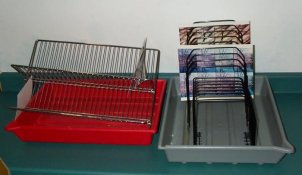OK. Things went well yesterday. I made a couple of newbers but all in all it turned out good. A couple of questions. Bear in mind that I am printing on a budget.
1. I dry the prints after washing in folded up Shamwows (I know) and though they do absorb the water they do not remove it from the surface of the print. Today I ran a fan across them for about thirty minutes and they were dry as a bone. Does it hurt any to leave the prints in an EVER-SO-SLIGHT state of being damp overnight?
Actually, next two aren't post printing but I wanna ask them.
2. If I make a print with a few MINISCULE white spots (I know its dust on the neg) would it hurt the neg to blow them off using compressed air, held away from the neg so as not to assault it with a gust?
3. I have an OLD two board easel that gives fuzzy edges to the image I can crop but the paper doesn't lay PERFECTLY flat on the easel. Short of laying a piece of glass on top is there a trick to flattening the paper out for focus' sake? A small piece of tape affixed to the back perhaps?
More questions as I think of them. I just might set up again this weekend. I know now I didn't buy enough paper. 250ct sheaf will be gone in a couple of months if I keep this up.
1. I dry the prints after washing in folded up Shamwows (I know) and though they do absorb the water they do not remove it from the surface of the print. Today I ran a fan across them for about thirty minutes and they were dry as a bone. Does it hurt any to leave the prints in an EVER-SO-SLIGHT state of being damp overnight?
Actually, next two aren't post printing but I wanna ask them.
2. If I make a print with a few MINISCULE white spots (I know its dust on the neg) would it hurt the neg to blow them off using compressed air, held away from the neg so as not to assault it with a gust?
3. I have an OLD two board easel that gives fuzzy edges to the image I can crop but the paper doesn't lay PERFECTLY flat on the easel. Short of laying a piece of glass on top is there a trick to flattening the paper out for focus' sake? A small piece of tape affixed to the back perhaps?
More questions as I think of them. I just might set up again this weekend. I know now I didn't buy enough paper. 250ct sheaf will be gone in a couple of months if I keep this up.



